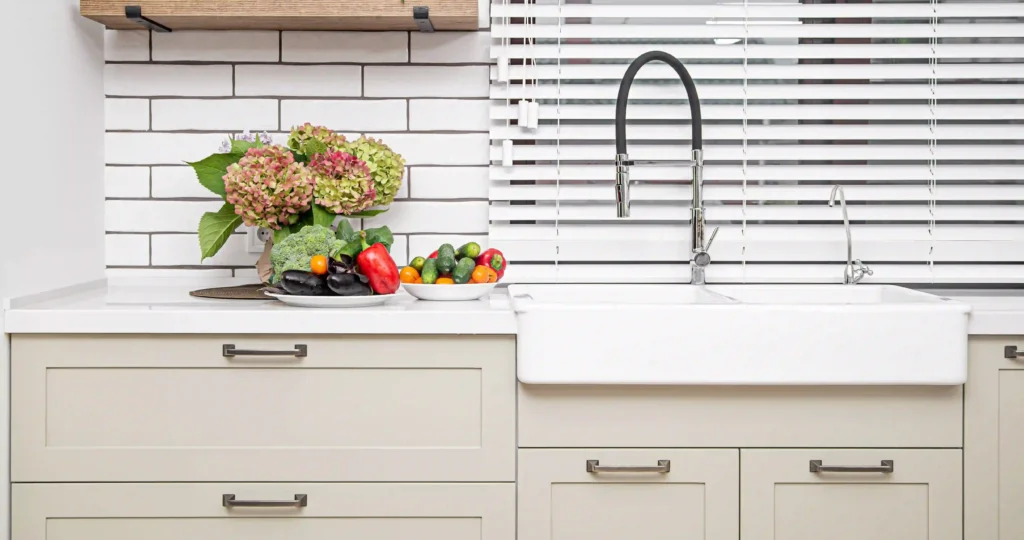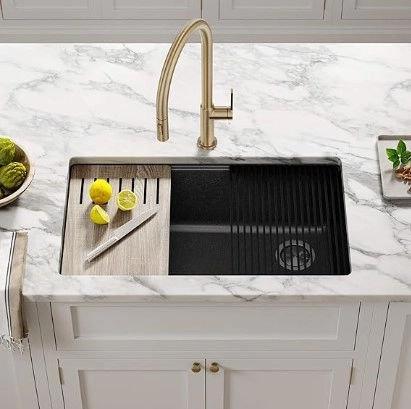Whether you plan to install a new sink or replace it, knowing how are kitchen sinks measured is one of the biggest first steps. Accurate measurements ensure that your new washbasin enhances the overall operation of your kitchen, fits just perfectly into your counter, and aligns with your plumbing. Whether you are switching from a double-bowl sink to a single-bowl sink, upgrading to a contemporary design or simply replacing an old sink, knowing the correct measurements helps you avoid costly mistakes and installation dilemmas.
Evaluating three primary aspects — length, breadth and depth — will allow you to assess a kitchen sink. While the width is the distance from the front edge to the rear edge, the length — from one side of the washbasin to the other — is what Conversely, the depth is the vertical distance the sink’s top edge travels from to the basin’s bottom.
If you are replacing an old sink, also measure the cutout size on your countertop. It is the hole where the sink (especially drop-in and undermount sinks) will go. Additionally, if there are pre-drilled tap holes in your sink, you will need to measure the distance between holes to ensure compatibility with your tap and additional fittings.
The method is straightforward when you have the right tools — a measuring tape, pencil and paper. Double checking your measures is always a good idea to prevent mistakes. Taking accurate measurements of your kitchen sink will spare you the headaches of incorrect installs, returns or adjustments.
We will take you step-by-step through the precise measuring of a kitchen sink and discuss standard sink sizes and tips to ensure a smooth fit! So let’s dive right in to avoiding disaster with your kitchen renovation project.
Contents
Why Measuring Your Kitchen Sink Matters
Whether upgrading or installing a kitchen sink, it is essential to correct the dimensions. A poorly measured sink can create all kinds of headaches, from the wrong fit to pricey do-overs. Knowing how to measure your kitchen sink makes the installation process simple for repairs or a new sink replacement.
Going through Compatibility Issues Avoided —measuring your kitchen sink is the top can. These are available in various sizes, styles, and designs, like single-bowl, double-bowl, and farmhouse kitchen sinks. Without precise measurements, you might buy a basin that won’t fit in your countertop’s cutout or leave gaps that could cause water leaks.
Also, slicker install plus toilet plus bath dry sink for eldritch esthetes. For example, you will need to measure the opening in your countertop when replacing a drop-in sink. At the same time, undermount sinks need measurements along the edge of your sink and countertop to ensure the perfect fit.
Another factor to take into consideration is faucet placement. Specific sinks are pre-drilled for holes for faucets, soap dispensers, or sprayers. The distance between those holes will tell you whether your new sink will align with your existing plumbing setup.
Lastly, measuring your kitchen sink can help you save time and money. Secondary to a sink that doesn’t fit is the hassle of returning the sink or hiring a professional to make adjustments if you have actual dimensions. It also allows you to budget for additional extras, like a deeper sink or a larger basin, without compromising your kitchen’s function.
All in all, reassessing your kitchen sink is a small but vital consideration in any replacement or renovation project. It guarantees a spot-on fit, avoiding expensive errors and helping you pick a sink that works with your kitchen’s design and function.
Tools You’ll Need to Measure a Kitchen Sink
Measuring a kitchen sink is simple enough, but accurate results rely on having the right tools on hand. If you install a new sink or replace an old one, these tools will ensure precise measurements and make the job easier.
- Measuring Tape: A flexible measuring tape is perhaps your most essential tool. It allows you to accurately measure your sink’s length, width, and depth. Select a tape with clear markings for better visibility.
- Pencil and Paper: Have a pencil and paper to record your measurements. This keeps you organized and helps you not miss any critical dimensions.
- Level : A level is a helpful tool to determine whether your sink is installed evenly. It is not necessary for measurement but useful for installers.
- Template : Many sinks include a template with the exact cutout size needed for installation. Use it to double-check your measurements if you have one.
- Straight Edge or Ruler: A straight edge or ruler can measure specific areas more precisely on sinks with uneven shapes.
- Flashlight (Optional): If your sink is installed in a dimly lit area, a flashlight can help you see the edges and corners clearly.
Before measuring, check that your tools are clean and in good condition. Measurement tape goes out of order. Average measurement dim. If you’re measuring to replace a sink, clean the area surrounding the sink so that you don’t have a barrier to measuring all edges.
If you have all the right equipment, it will streamline the measuring process and ensure you get measurements as correct as possible to ensure that your new sink fits. Armed with these tools, you’ll be ready to approach any kitchen sink measuring task with confidence.
Step-by-Step Guide: How to Measure a Kitchen Sink
While it sounds tricky, taking kitchen sink measurements is pretty simple if broken down into steps. Follow this advice to ensure accurate measurements of your replacement or new washbasin.
Step 1: Measure the Length and Width
Begin by measuring the outside perimeters of your sink. With a measuring tape, determine the depth from front to back and the width—from side to side. If that rounded edge on your washbasin needs it, measure from the widest points.
Step 2: Measure the Depth
So measure the sink’s depth then. Pull the measuring tape up to the top edge from the bottom of the sink.” This measurement is critical if you are replacing a washbasin and must ensure it fits within your cabinet space.
Step 3: Measure the Cutout Size
If you are replacing a drop-in sink, you will have to measure the countertop cutout. (if possible) remove the washbasin, then measure out the width and length of the cutout. For under-mount sinks, mark the inside edges of the countertop where the sink will sit.
Step 4: Measure the Faucet Holes
If you have pre-drilled faucet holes in your sink, measure the distance between them. This ensures that your new sink works with your existing tap configuration or allows you to make plans for your fixtures.
Step 5: Double-Check Your Measurements
Lastly, check all your measurements again to ensure accuracy. Write them down and pitch them against the specs of the sinks you’re considering.
Adhering to these guidelines will help you get all the necessary information to choose a washbasin that would suit your kitchen perfectly. Measuring to the millimeter saves time.

Conclusion
It seems like a little issue, but doing a kitchen sink measure is very important for repairing or replacing a kitchen. how are kitchen sinks measured Whether replacing an old washbasin or upgrading it to a modern look, correct measurements are a prerequisite for the basin to fit perfectly in the kitchen or washroom zu.
You must focus on The three main dimensions when measuring a kitchen sink: depth, width, and length. Measure the outer edges of the sink first to calculate the overall dimensions. Add the basin’s height from the top edge to the bottom. If you are replacing a sink, measure the cutout size on your countertop accurately to ensure that the new sink will fit snugly into the space. This is important because the sink will be useless if the distance between your pre-drilled sink tap holes does not match your plumbing arrangement.
The process is straightforward with the right tools — a measuring tape, pencil,, and paper. A level or template will help you achieve even greater precision for more complicated washbasin designs. It is always worth rechecking your sizes to avoid costly mistakes or the hassle of a return of a washbasin that cannot be fitted.
Measuring a kitchen sink is a simple but essential task that ensures a perfect fit. By following the advice contained within this book, you will save time, money, and effort while producing a professional result. Ready to jump to the next level? Check out our other guides on choosing your perfect kitchen sink and installation tips to help you finish your project like a pro!
FAQs
- What Are the Standard Dimensions of a Kitchen Sink?
The type of sink influences the standard proportions for how are kitchen sinks measured . Single-bowl sinks are typically around 22 inches by 30 inches; double-bowl sinks are more extensive and usually span 33 to 48 inches in width. While most kitchen sinks are between 8 to 10 inches deep.
- How To Measure A Kitchen Sink Replacement?
Start by measuring the sink from side to side to determine the width and length of a replacement kitchen sink. Then, measure the depth of the basin from the top edge down to the bottom.
- How Do I Measure the Cutout Size for a Kitchen Sink?
Take out the sink — at least if you can remove it — and measure the width and length of the opening in your countertop to find the cutout size. If the washbasin is still fitted, take note of the inner edges of the countertop where it rests.
- Can I replace a double-bowl sink with a single-bowl sink?
You can swap a double-bowl sink for a single bowl, but you need to measure the cutout size on your countertop to ensure the new sink will fit.
- How Do I Measure a Sink for an Undermount Installation?
Measure the width or length of the countertop cutout area where the undermount sink will go. Also, measure its depth to ensure it will fit in your cabinet. Undermount sinks sit below the countertop.
- What Tools Do I Need to Measure a Kitchen Sink?
Measuring your kitchen sink will require a measuring tape and possibly a pencil and paper to write everything down. A spirit level will ensure the washbasin is level; if unsure, a template will provide greater precision.



